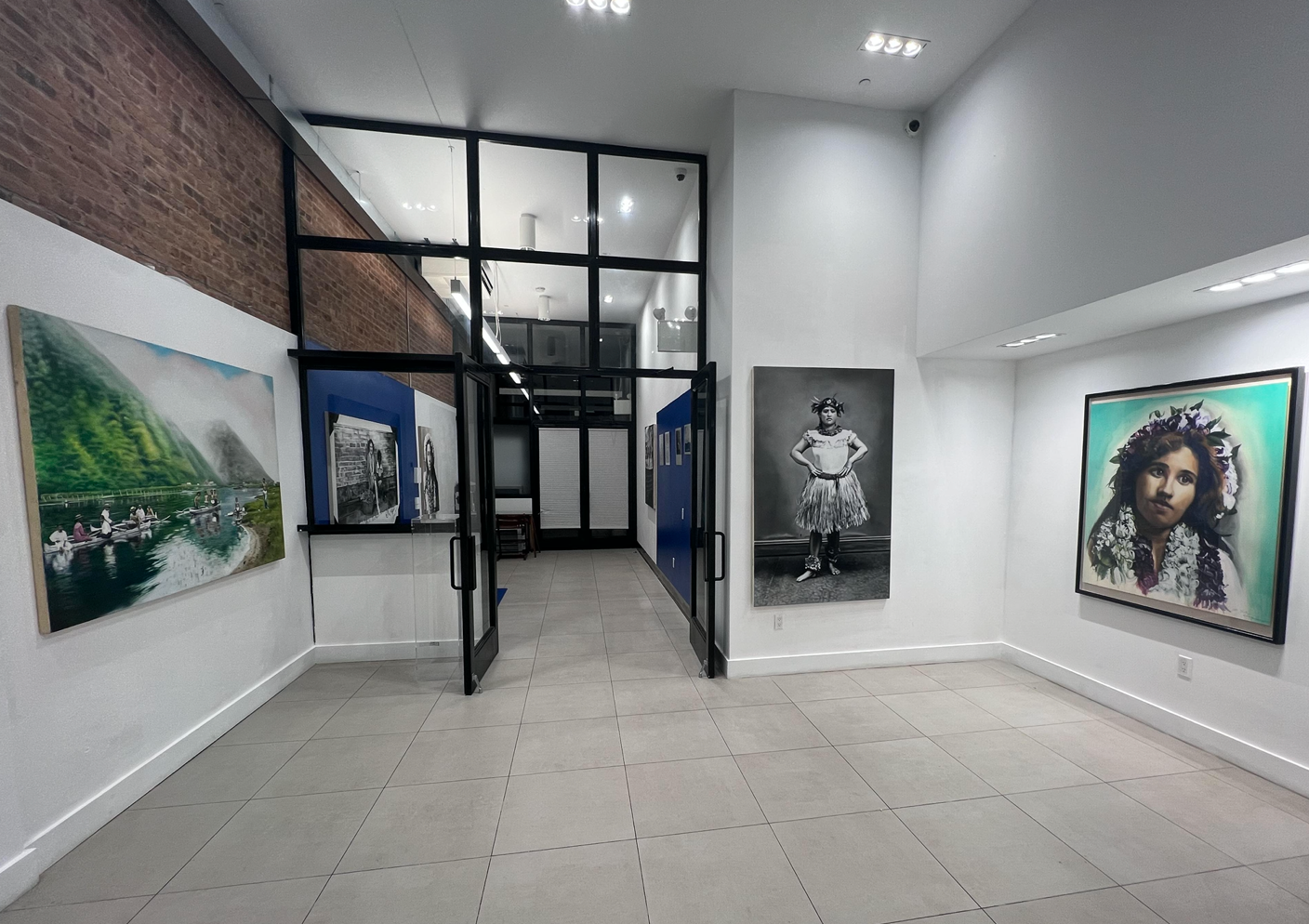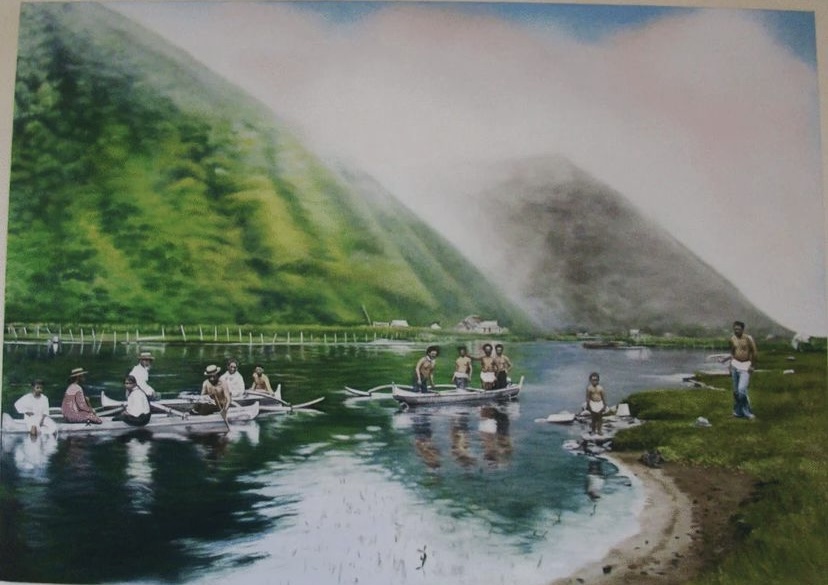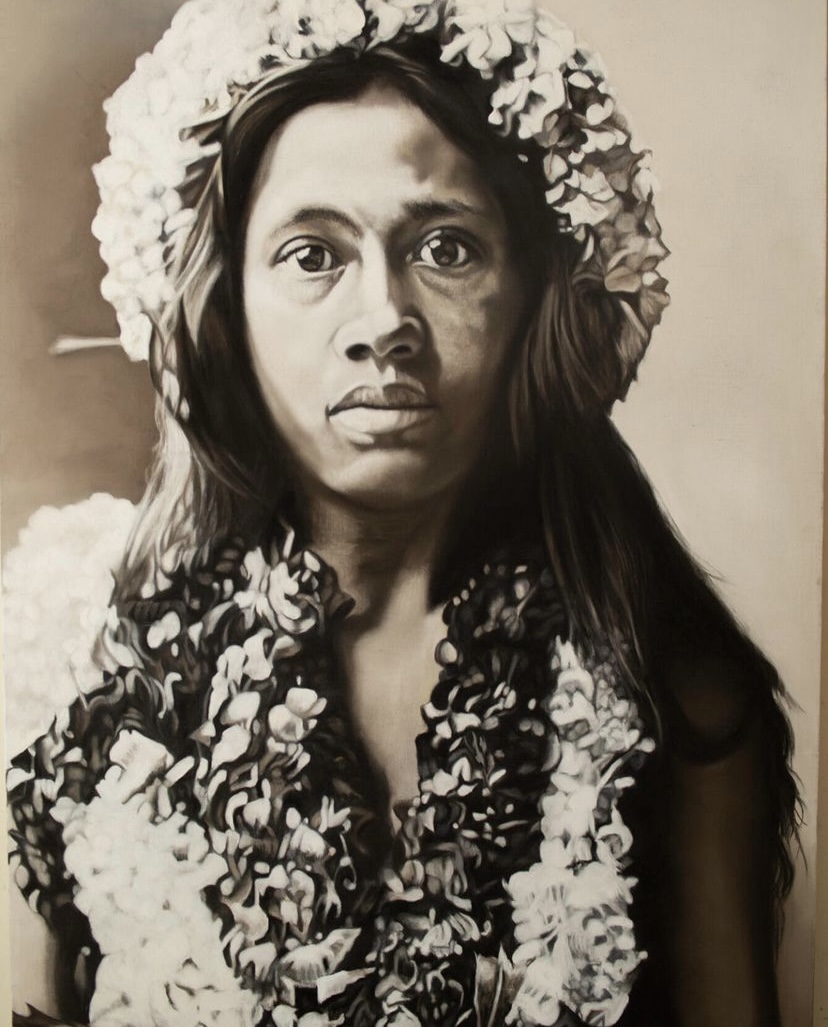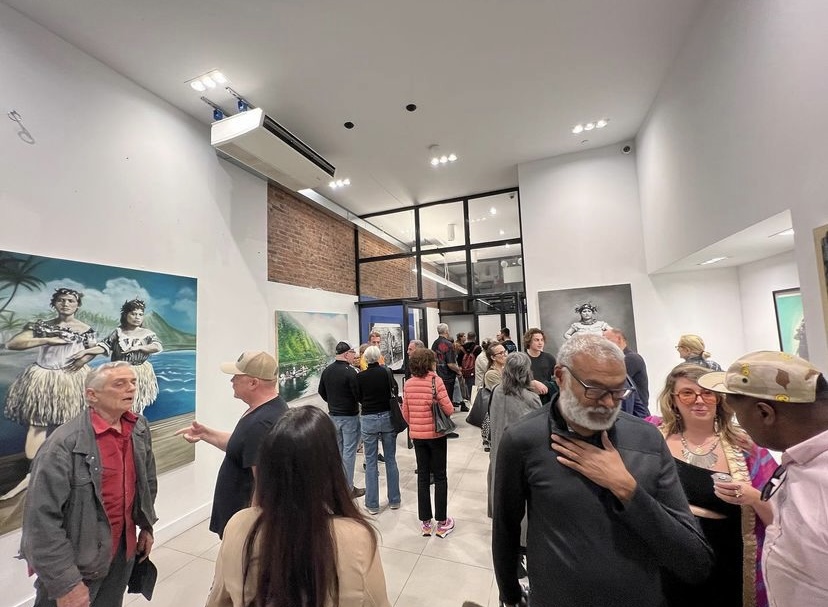Pedagogic side of this undertaking: “To educate the image-making medium within us, raising it to a stereoscopic and dimensional seeing into the depths of historical shadows.”
From Rudolf Borchardt’s Epilegomena zu Dante, v. 1[Berlin 1923] pp. 56-7
Walter Benjamin, The Arcades Project (N 1, 8), 458.
The Opening Gallery is pleased to present Michele Zalopany's critically-acclaimed paintings and drawings that draw from archival photographs that the artist discovered while researching her Hawaiian ancestry and the erased culture of the internationally recognized sovereign nation of Hawai’i.
The country was formed in 1795, when the warrior chief Kamehameha the Great, of the independent island of Hawaiʻi, conquered the independent islands of Oʻahu, Maui, Molokai and Lānaʻi and unified them under one government. In 1810, through diplomatic means, Kauaʻi and Niʻihau joined the Hawaiian Kingdom voluntarily. On November 28, 1843, Hawai’i was an Independent nation and was recognized as such by major powers and had treaties with 90 countries. Two dynastic families ruled the kingdom: the House of Kamehameha and the House of Kalākaua, until after a series of attempts by capitalists to overthrow the Kingdom, they finally succeeded in 1893. In 1897, The Kingdom of Hawai’i, against the overwhelming majority of the Hawaiian people, was forced to become a territory of the United States, until 1959 when it became the 50th state of the USA. This is contested by a Hawaiian movement who consider Hawai’i an occupied country.
Current attempts to suppress the true history of enslaved and indigenous people are not new. In the early 19th century settler colonialists weaponized religion, conflated with racial ideology, to ruthlessly destroy every aspect of Hawaiian culture (hula, chants, both of which recorded and transmitted history, surfing, etc) in order to possess and capitalize land that was inhabited for centuries by Native Hawaiian people. Western models of land ‘ownership’ did not exist in Hawai’i. Traditionally, in Hawai’i, ‘Āina (land) was not owned but was held in trust. It was the Akua, or Gods, who had made the ‘Āina, if anyone, it was the Akua who owned the ‘Āina. Moreover, having been born of the Akua, the ‘Āina itself is an Akua, In Native Hawaiian culture, if an Akua cannot be owned, then no one can buy and sell an Akua, Land use functioned as a sophisticated form of organized ‘caretaking’, headed by a Mōi, Chief, and a series of his administrators, Konohiki to the Maka ‘āinana, common people who worked the land. This form of shared land use based on spiritual beliefs and acquired knowledge and respect for the land made certain that all people were taken care of.
The photographs on which these works were based were taken by haoles (white foreigners) for their various intentions. Behind each photographic image is a story that has led me to the nexus of uncovering the darkness and tragedy of the cultural and historical annihilation that affected Pacific Islanders for centuries. This erasure was supplanted with the narrative “false paradise” by colonial capitalists for profit. This false narrative and its constructed ‘culture’ are so deeply and empirically entrenched in the minds and lives of people that the islands now risk existential annihilation. One can follow the struggles of Kanaka Maoli (native Hawaiians) in the ashes of Maui, fighting for control of the 75% of the water-rights that are currently controlled by private companies, and to ‘rebuild’ using indigenous and sustainable ways.
In this process of searching for images, I have a dialogue with them. We ‘talk story.’ They have led me to uncover the buried knowledge in their images and in documents and in my own genealogy, which intuitively leads me to search for more knowledge and images. I am bringing their story and my story to light by unveiling the layers of the historical shadows with the hope that they might provoke questions in the minds of viewers. My ultimate intention is to make a crack in the false narrative about Hawai’i that prevails today, and to contribute to restoring the truth of what really happened to the Kanaka Maoli, Native Hawaiians, and their Āina.
Michele Zalopany is an American Postwar & Contemporary artist who was born in 1955. Michele Zalopany's work is featured in Public Collections including: Whitney Museum of American Art, New York, NY, Bayer Inc., Pittsburgh, PA, Bemis Center for Contemporary Arts, Omaha, NE, Eli Broad Foundation, Los Angeles, CA, Carnegie Museum of American Art, Pittsburgh, PA, Chemical Bank, New York, NY, S.I. Newhouse, New York, NY, Yokohama Museum of Modern Art, Yokohama, Japan, Norton Museum, West Palm Beach, FL, UBS Art Collection, Zürich, Switzerland, San Francisco Museum of Modern Art, San Francisco, CA, Thomas Ammann, Zürich, Switzerland, Walker Art Center, Minneapolis, MN, Minneapolis Institute of Art,, Minneapolis, MN, Nestle Art Collection, Geneva, Switzerland, JPMorgan Chase Art Collection, New York, NY, Matthew Bronfman, New York, NY, Fisher Landau Center for Art, Long Island City, NY, Henry Art Gallery, Seattle, WA, Museum of Fine Arts, Boston, MA, Cleveland Museum of Art, Cleveland, OH, The New York Public Library, New York, NY, National Gallery of Art, Washington, D.C., The Royal College of Art, London, England, Horst-Janssen-Museum, Oldenburg, Germany, The Minnesota Discovery Center: The Museum of the Iron Range, Chisholm, MN. Michele Zalopany' s oeuvre has been featured in The New York Times among other publications. The artist has taught as Adjunct Professor at the School of Visual Arts since 2001 and Harvard University 2007 - 2009.
2022 Joan Didion: What She Means, Hammer Museum, CA
2017 Drawings, Collage & Paintings, Max Fish, New York, NY
2016 BIG PICTURE, Galerie Manqué Brooklyn, NY
2015 Image is Everything, Geoffrey Young Gallery, Great Barrington, MA
2013 NY Again, Gesso Artspace, Vienna, Austria
2010 Plus One, Perry Rubinstein Gallery, New York, NY
PooL, Gershwin Hotel, New York, NY
2009 Visiting VES Faculty Exhibition, Harvard University, Cambridge, MA
Art/40/Basel/10-14/09, Thomas Ammann Fine Art AG, Basel, Switzerland
2008 Art of Healing, Bayfront Health Foundation, St. Petersburg, FL
Visiting VES Faculty Exhibition, Harvard University, Cambridge, MA
2007 Drawing Selections from the USB Collection, Tate Modern, London England
Liscio e Ruvido, Irtus Galleria, Sutri, Italy
2006 Seeing…Blue curated by Charles Schieps, Buck House Gallery, New York, NY
Commemoration of Orphans International Worldwide, United Nations, New York, NY
2000 Drawings & Photographs, Matthew Marks Gallery, York, NY
Art in America: 2000, American Embassy, Bratislava, Slovakia
1999 Review/Preview, Associated American Artists, New York, NY
1996 Romantico Contemporaneo curated by Alice Rubini, Castello di Bentivoglio, Bentivoglio, Italy
Chair Event to benefit Friends Indeed, Sotheby’s, New York, NY
1993 La Montagna Dipinta, Raffaelli Studio d’Arte, Trento, Italy
Drawing the Line Against AIDS 45th Venice Biennale, Peggy Guggenheim Collection, Venice, Italy
Grande Lubro curated by Achille Bonita Oliva, Erice, Sicily, Italy
The Return of the Exquisite Corpse, The Drawing Center, New York, NY
1991 Anni Novanta curated by Renato Barilli, Galeria Communale d’Arte Moderna, Bologna, Italy
1990 Collector’s Annual: Contemporary Art, Norton Museum of Art, Boca Raton, FL
New York: A New Generation, San Fransisco Museum of Modern Art, San Francisco, CA
1989 Whitney Biennial, Whitney Museum of American Art, New York, NY
The Silent Baroque curated by Christian Leigh, Galerie Thaddeus Ropac, Salzburg, Austria
The Observatory, Tom Soloman’s Garage, Los Angeles, CA
1988 The Inside and The Outside curated by Christian Leigh, Rhona Hoffman Gallery, Chicago, IL
1987 In Black and White curated by John Caldwell, The Carnegie Museum of Art, Pittsburg, PA
1986 The Benefit for the Poetry Project, St. Marks Church, New York, NY
The Potent Image, Morris Museum of Art, Morristown, NJ
Hyperspaces, Art City, New York, NY
Stimulations, John Good Gallery, New York, NY
Fictions, Kent Fine Art and Curt Marcus Gallery, New York, NY
Memorabilia, Mazzoli Gallery, Modena, Italy
1985 57th Between A&D, Holly Solomon Gallery, New York, NY
Precious: A Cottage Industry, Grey Gallery, New York, NY
Select Bibliography
2020 Ann McCoy, review, Brooklyn Rail, March 2020, brooklynrail.org
2008 Harper’s Magazine, Jimmy Hoffa Bar, illustration. p.25
2007 Michael J. Amy, Ph.D, review, Art in America, February, p.150
Deanna Petherbridge, review, Perspectives on Art, telegraph.co.uk,
November 26
Kate Moss, review, Perspectives on Art, telegraph.co.uk, November 26
Mimmo Coletti, review, Michele Zalopany e la solitutide di Coney Island,
La Nazione Umbria, 25 novembre
Dan. Bo., review, Il luogo simbolo dell’immaginario Americano E’la Coney
Island nelle tele della Zalopany, La Voce di Perugia, 22 novembre
Review, Il luna park di Brooklyn e sbarcato a Perugia, Il Messaggero
Umbria, 12 dicembre
R.P., review, I lini ed I pastelli di Michele Zalopany, Sette Giorni Umbria,
7 dicembre
2006 Letizia Rittatore Vonwiller, Diritti Neri, AMICA, September 2006,
Pgs. 366-371
James Wagner, review, jameswagoner.com, October 4
Edward Hamilton, Michele Zalopany’s disIntegration, Living with
Legends: Hotel Chelsea Blog, September 26
James Morris, review, diggingpitt.blogspot.com,
HomeTeam, Disintegration in Pastel, wenited.com
Sam, review, worldart.com.au, September
2004 Walter Robinson, “Miami Heat,” Artnet, December 2004, online
Glenn O’Brien, editor, “Bald Ego #3,” 2004,
2003 Daniela Morera, “Chelsea Hotel, se non hai vissuto qui non sei
Nessuno,” AMICA, April 2003, p.150
2002 Carl Mellor, “In the Ball Park,” Syracuse New Times Net,
February 13, 2002, online
David Rimanelli, “Also of Note,” ArtForum, March 2003, p.130
2000 Kelly Grinsteinner, “Governor Perpich Memorial,”The Daily Tribune,
August 2000, p.150
1999 Review of Michele Zalopany solo exhibition, New Yorker, December 6
2000, p.30
Robert Mahoney, “Art Reviews,” Time Out New York, December 1999,
Hora Rapit Deum, p.110
Michael Rips, text, “Eidetic Vestiges,” exhibition catalog,
December 1999
1998 Grace Glueck, “Art Reviews”, The New York Times, June 5 1998
Lynn Crawford, “Art Reviews,” zingmagazine, 1998
1996 “Romantico Contemporaneo Castello Bentivoglio,” curated by Alice
Rubini, illustrated exhibition catalog, January 1996, pp. 76-77
“Special Project,” Juliet, December 1995-January 1996, pp. 30-31
Gabriele Peretta,“La Montagna Dipinta,”, illus. exhibition catalog, 1996,
Giovanna Nicoletti, “Dipingere la Montagna Speechio della Vita,”
Venerdi, pp.28-29
“Michele Zalopany,” Juliet, no. 63, illus: Montagna Vietnamita,
June, 1996, p.52
1993 Marsha Miro, “Detroit-born Artist’s Drawings Reinterpret the Beauty
Of The Past,” The Detroit Free Press, June, 1993, p.6E
Joy Hakanson Colby, “Review Michele Zalopany,” The Detroit News,
June 25 1993, p. 2D
1992 Ellen Daspin, “Lives of the Artists,” W, Oct./Nov. 1992, pp.18-19
Robert Mahoney, “Unlearning at …,” Arts Magazine, March 1992,
pp.81-81
1991 “Review Michele Zalopany,” Trova Roma, illus:
Stone Elephant, June 29 1991, p.25
Massimo Carboni, “Michele Zalopany at Alessandra Bonomo,” Flash
Art, October-November 1991, p. 148
Brooklyn Review, cover illustration, “Untitled,”
“The Library,” curated by Douglas Blau, illustrated exhibition catalog,
Josh Baer Gallery, New York
“Michele Zalopany”, book, Art Random Publishers, Kyoto Shoin, Japan
1990 Ben Brantly, “Bohemian Grooves,” Vanity Fair, January 1990,
pp. 100-104
KK Kozik, “Calvary of the Ideal,” Cover, September 1990
Nancy Jones, “Pools,” catalog for exhibitions in Moscow and Zurich,
March – June 1990
John Caldwell, “New Work: A New Generation,” The San Francisco
Museum of Modern Art, exhibition catalog, illus. The Bedroom, 1990
Collector’s Annual Contemporary Art, Norton Museum of Contemporary
Art, exhibition catalog, 1990
Gary Schwan, review of exhibition, The Palm Beach Post, illus: Garden,
March 2, 1990
1989 Nancy Jones, “Michele Zalopany,” New York Woman, vol. 4, May 1989,
Illus: Forum, p.40
Robert Mahoney, “Barking for Art,” New York Press, illus: Bequest,
May 19, 1989, pp.12-13
Robert Mahoney, “New York in Review,” Arts Magazine, illus: Untitled
(Men at Sea), p. 101
Amei Wallach, “76 Artists as Capitalists,” New York Press,
illus: Bequest, May 1989, pp.12-13
Richard Marshall, “1989 Whitney Biennial Exhibition,” exhibition
Catalog, May 1989
Christopher Knight, “A Photo Observatory,” Los Angeles Herald
Examiner, June 16, 1989
David Trinidad, Paris Review, frontispiece illus: Untitled (Hotel)
February 1989
Tema Celeste, illus: Black and White
Douglas Blau, “The Observatory,” exhibition catalog, Tom Soloman’sGarage, 1989
1988 Claudia Hart, “Michele Zalopany,” Artscribe, January/February 1988
Roberta Smith, “Group Show Survey: Downtown Galleries,” The
New York Times, June 10 1988
Phyllis Floyd with Kevin Arnfield, “Art of the Eighties: Artists from
the Eli Broad Family Foundation Collection,” catalog, 1988
1987 Patty Harris, “Stimulation,” 108 Magazine, September/October 1987
Michael Laurence, “Michele Zalopany,” Flash Art International, illus:
King Pleasure, October 1987
John Yau, “Black and White,” ArtForum International, illus: The First,
Without Them, November 1987, p. 114-115
John Caldwell, “In Black and White,” The Carnegie Institute of Art,
exhibition catalog, January-February, 1987
Ruggero Prazio, “Los Angeles, review of solo exhibition at Hoffman-
Borman,” Juliet, no. 33, October-November 1987, p.47
Douglas Blau, “Fictions,” exhibition catalog, Kent Fine Art & Curt Marcus
Galleries, November 1987, fig. 95
1986 Tom Cugliani, “AMORE, DOLORE, SACRUM,” exhibition catalog,
John Good Gallery, May 1986
Gary Indiana, “Insomnia,” Village Voice, illus: At Home in the World, May
1986
Judy Stevens, “Michele Zalopany,” 108 Magazine, September-October 1
1986
Robert Ferguson, “The Potent Image,” exhibition catalog, The Morris
Museum, September 1986, p.4
1985 Sarah Cecil, “Michele Zalopany,” Artnews, illus: Vertical Sufferings,
February 1985, p. 118
Charles Hagen, “Michele Zalopany,” ArtForum, February 1985, p.120
Ron Warren, “57th Between A & D/ Allen Ginsburg,” Arts Magazine,
April 1985, p.64
Michael Brenson, “The Chi-Chi Show,” The New York Times, April 1985,
p.100
Jane Warrick, images, BOMB, Fall/Winter, 1985, pp. 86-87
Demetria Daniele, “John Good Opens Gallery with Dan Asher and
Michele Zalopany,” Soho Arts Weekly, October 1985
Frederick Ted Castle, “Michele Zalopany at PPOW,” Art in America,
illus: The Palace of Janus, December 1985
Roland Hagenberg, “East Village 1985: A Guide Book,” 1985
Thomas Sokolowaski, “Precious: An American Cottage Industry
of the Eighties,” Grey Art Gallery, NYU, March 1985, p.6
“Out of Context,” exhibition catalog, Piccadilly Gallery, London, England,
June 1985
1984 Walter Robinson and Carlo McCormick, “Promising Debuts,
East Village Eye, illus: Apollonia, November 1984, p.24
Vivian Raynor, “Michele Zalopany,” The New York Times,
November 1985 3C
Tetsu Fukaya, “Neo-T Chromosome,” Brutus, November 1985, p.29
Gini Alhadeff, “Neo-Galleristi,” L’Oumo Vogue, December 1984, p.123
Valerie Smith, “Selections,” Artists Space, November 1985
John Caldwell, “Exhibition Announcement, “ PPOW Gallery,
November 1984
Carlo McCormick, supplement to the Neo-New York catalog, p.10
Phyllis Pious, “Neo-New York: Report on a Phenomenom,”
University Art Museum, Santa Barbara, CA, November 1984, p.9/51





